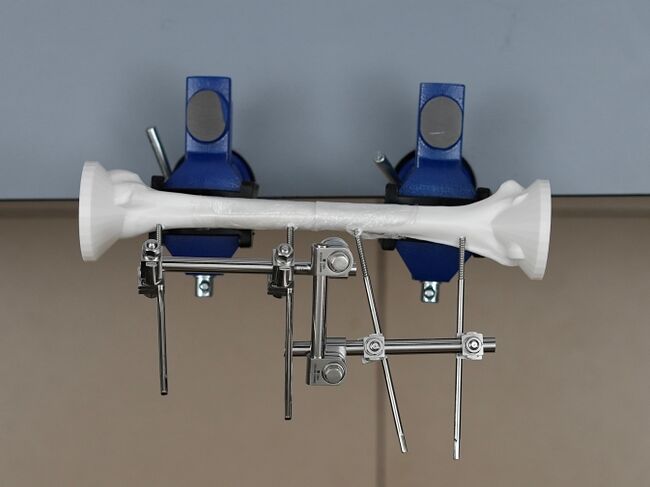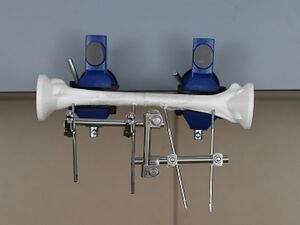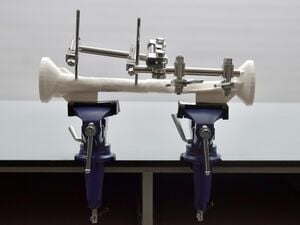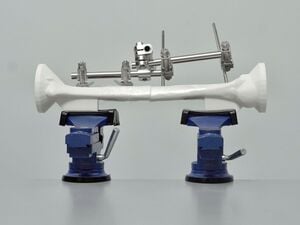
This skills module allows medical officers and surgeons who are not orthopedic specialists to become confident and competent in performing irrigation and debridement, power and manual drilling, proper positioning and insertion of Schanz screws, construction of the rod-to-rod modular frame, and fracture reduction and stabilization as part of external fixation procedures for open tibial shaft fractures performed in regions without specialist coverage. To maximize patient safety, this module teaches learners to use a powered drill to insert self-drilling Schanz screws through the near cortex and then manually advance Schanz screws into the far cortex to avoid plunging.
Self-Assessment Framework[edit | edit source]
After the reduced fracture has been stabilized with the modular external fixator, please follow the 3 steps below, use a cellphone to take 3 post-operative photos ("digital X-rays"), and fill out the printed Training Logbook.
- Take an anterior view photo with a ruler (not shown) in the image to provide scale.
- Visually inspect the humeral shaft and confirm that the reduction is within acceptable parameters:
- > 50% bone apposition
- < 15° malrotation (at 0° of rotation the patient's palm is facing straight up towards the ceiling when the patient is supine and the forearm is supinated)
- < 30° varus/valgus angulation
- < 3 cm limb shortening
- Use a ruler to measure the distance of the two near Schanz screws from the fracture line:
- Two near Schanz screws were placed at least 2.0 cm (a finger breadth) from the fracture line
- Use a ruler to measure the distance of the far Schanz screw in the distal fragment from the lateral epicondyle:
- Far Schanz screw in the distal fragment is at least two fingers’ breadth proximal to the lateral epicondyle
- Take a lateral view photo.
- Confirm both near and far Schanz screws were inserted anterolaterally into the proximal fragment.
- Confirm both near and far Schanz screws were inserted laterally into the distal fragment.
- Take a medial view photo.
- Verify that all four Schanz screws did not perforate the far cortex.
- Visually inspect the humeral shaft and confirm that the alignment is within acceptable parameters:
- > 50% bone apposition
- < 20° anterior angulation
Training Module Certificate of Completion[edit | edit source]
Once the self-assessment framework has been completed:
- Click the button above.
- Type in your name, download and print out a certificate of completion for this training module.
- Photograph your certificate on your cellphone as a backup and file the printed certificate in your training records.
Acknowledgements[edit | edit source]
This work is funded by a grant from the Intuitive Foundation. Any research, findings, conclusions, or recommendations expressed in this work are those of the author(s), and not of the Intuitive Foundation.



